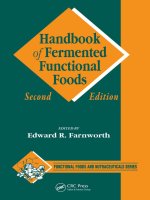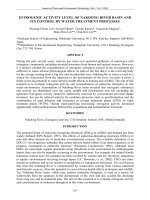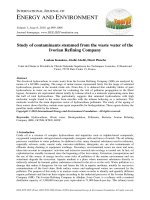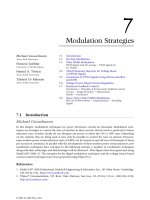Refining processes handbook
Bạn đang xem bản rút gọn của tài liệu. Xem và tải ngay bản đầy đủ của tài liệu tại đây (23.44 MB, 736 trang )
REFINING PROCESSES
HANDBOOK
Surinder Parkash
AMSTERDAM BOSTON HEIDELBERG LONDON
NEWYORK OXFORD PARIS SANDIEGO
SANFRANCISCO SINGAPORE SYDNEY TOKYO
Gulf Professional Publishing is an imprint of Elsevier
Gulf Professional Publishing is an imprint of Elsevier.
Copyright © 2003 by Elsevier. All rights reserved.
No part of this publication may be reproduced, stored in a retrieval system, or transmitted in
any form or by any means, electronic, mechanical, photocopying, recording, or otherwise,
without the prior written permission of the publisher.
/ ^ N Recognizing the importance of preserving what has been written, Elsevier prints its books
^ - ^ on acid-free paper whenever possible.
Library of Congress Cataloging-in-Publication Data
A catalog record for this book is available from the Library of Congress.
ISBN: 0-7506-7721-X
British Library Cataloguing-in-Publication Data
A catalogue record for this book is available from the British Library.
The publisher offers special discounts on bulk orders of this book.
For information, please contact:
Manager of Special Sales
Elsevier
200 Wheeler Road
Burlington, MA 01803
Tel: 781-313-4700
Fax: 781-313-4882
For information on all Gulf Professional publications available, contact our World Wide Web
home page at:
10
9 8 7 6 5 4 3 2 1
Printed in the United States of America
Cover Photo by Mieko Mahi, energyimages.com
To My Wife
RITA
Preface
Petroleum refineries have grown rapidly in complexity and so, too, the
refinery operations. However, the published information on the refinery
processes and operation is scant and mostly confined to licensor's data,
which reveal little beyond what is absolutely necessary for process sale,
even when these processes have been in operation for a number of years
and in many refineries. This book is an overview of the processes and
operations concerned with refining of crude oil into products. The streams
coming from processing units are not finished products; they must be
blended to yield finished products. The refining operations presented here
are those concerned with blending products in an optimum manner with
the twin objectives of meeting product demand and maximizing refinery
profit. The objective here is to provide basic instructions in refinery
practices employing the methods and language of the industry.
Presented in the book are refinery processes, such as crude desalting and
atmospheric and vacuum distillation; gasoline manufacturing processes,
such as catalytic reforming, catalytic cracking, alkylation, and isomerization; hydrodesulfurization processes for naphtha, kerosene, diesel, and
reduced crude; conversion processes such as distillate and resid hydrocracking; resid conversion processes such as delayed coking, visbreaking, solvent
deasphalting, and bitumen manufacture; pollution control processes such as
sulfur manufacture, sulfur plant tail gas treatment, and stack gas desulfurization. Also presented here are operations performed in refinery off-site
facilities, such as product storage and blending, refinery steam and fuel
systems, refinery boiler feedwater treatment, and wastewater treatment.
The process details include processflowsheets,process description, chemistry involved, detailed operating conditions, process yields and utilities.
Among the refinery operations and practices presented are product blending,
refinery inventory forecasts, spreadsheet and LP modeling of refineries, and
methods for pricing crude oil, petroleum products, and intermediate stocks.
It must be recognized, however, that many variants of the same process
are found in the industry, and the operating conditions can be quite
diverse, depending on the type of catalyst used and feedstock processed.
We have insufficient space for bibliographic comparison and evaluations
of identical basic processes from different licensors. The data presented
here represent typical industrial operations practiced in refineries today.
Where no mention is made of recent contributions to the literature, no
slight is intended. The few references quoted are those where an industrial
practice is known to have originated.
Another important subject presented in this volume is concerned with
the operation of joint ownership refineries. Building a grassroots refinery
requires large capital investment. It is feasible for two companies to own
and operate a refinery as if it were build of two independent refineries.
Each company may operate its share of the refinery virtually independent
of other; that is, each company may bring in its own feedstock and
produce product slate independent of the other with no need to build
separate product storage facilities for the two companies.
The basic rules of operations of joint ownership refineries is discussed in
this book. A typical pro-forma processing agreement between the participants
is presented in the Appendix of this book. This covers detailed procedures for
refinery production planning, product allocation, inventory management, and
allocation of refinery operating cost to participants. Product allocation is the
split of total refinery production among the participants on the basis of the
feedstock processed by each. Keeping in view that the participants do not
process identical feedstocks or produce identical product grades, product
allocation for establishing the ownership of stock, must be done at the end
of every month. This is a complex exercise and a detailed procedure for this is
presented in a separate chapter.
The methods for preparing inventory forecasts and tracking refinery
operating expenses in a joint ownership refinery scenario are presented as
well. Even though such practices—product allocation, inventory and
ullage allocation, operating costs allocation—exist in refining industry,
there is no known literature examining them.
CHAPTER BREAKDOWN
Chapter 1 covers atmospheric and vacuum distillation and crude
desalting. Chapter 2 covers the refinery hydrotreating processes: naphtha
hydrotreating, kerosene hydrotreating, gas oil hydrodesulfurization
and atmospheric resid desulfurization. Chapter 3 presents the distillate
hydrocracking, mild hydrocracking, and resid hydrocracking processes.
Chapter 4 covers gasoline manufacturing processes: catalytic reforming,
alkylation, isomerization, catalytic cracking, and MTBE manufacture.
Chapter 5 looks at the manufacture of hydrogen for hydrotreating
and hydrocracking process and its recovery from some of the hydrogenbearing streams coming from these units. Chapter 6 presents refinery
residuum processing units, on delayed coking, visbreaking, solvent
deasphalting, and bitumen blowing.
Chapter 7 examines treating processes for catalytic cracker light and
heavy naphthas and kerosene-type jet fuels. Chapter 8 presents sulfur
manufacture and pollution control processes, such as sulfur plant, sulfur
tail gas treatment, and stack gas desulfurization.
Chapter 9 examines the refinery water system. This includes treatment
of cooling and boiler feed water, the refinery's oily waste water, and stripping the refinery's sour water.
Chapter 10 looks at the off-site and utility systems of a refinery. The
topics include the tankage requirements for product export and product
blending; batch and in-line product blending systems; refinery flare
system, including principals of flare system design; the refinery steam
system; and liquid and gaseous fuel systems.
Chapter 11 describes the procedures for product blending. Chapter 12
presents the procedure for preparing a refinery material balance using
a spreadsheet program. Chapter 13 describes the general principles
of building a refinery LP model. Chapter 14 discusses the mechanism
of pricing petroleum products, including intermediate streams and products. Chapter 15 describes the concept of a definitive operating plan for
the refinery during an operating period.
Chapter 16 shows the methodology behind product allocation in jointownership refineries. Chapter 17 explains methods of estimating available tankage capacity as a part of an inventory forecast system in both
single- and joint-ownership refineries. Chapter 18 explains how these
inventory forecasts are prepared for planning shipment of product in both
single-ownership and joint-ownership refineries. Chapter 19 presents
procedures for estimating the operating costs of the refinery and, in case
of joint-ownership refineries, the allocation of refinery operating costs to
the participants.
An appendix explains the organizational structure of joint-ownership
refineries and presents an example of a processing agreement among the
participants required for operating such a refinery.
We hope this book will serve as a useful tool for both practicing engineers
concerned with refinery operational planning as well as for academics.
Index
Index terms
Links
A
Alkylation
feed, product properties
138
operating conditions
136
process description
131
process variables
129
reactions
129
utility consumption
137
yields
137
Amine treating
amine properties
241
chemical reactions
236
feed and product composition
241
operating conditions
240
process (description)
238
utility consumption
240
239
Atmospheric resid desulfurization
catalyst
54
catalyst addition onstream
55
feed and product qualities
57
operating conditions
56
process description
50
process yields
57
utility consumption
58
This page has been reformatted by Knovel to provide easier navigation.
709
710
Index terms
Links
B
Bitumen Blowing
bitumen grades properties
207
feed and product properties
206
operating conditions
205
process description
205
utility consumption
206
C
Catalytic reforming
chemical reactions
110
feed and product properties
115
process description (semi-regenerative)
112
reforming yields
116
unit operating conditions
114
utility consumption
117
113
Claus tail gas treatment
catalyst
225
operating conditions
229
process description
226
process yields
230
system chemistry
223
utility consumption
230
229
227
D
Definitive operating program (DOP)
fixed and balancing grade products
505
input data
493
joint-ownership refineries
498
refinery DOP
499
This page has been reformatted by Knovel to provide easier navigation.
711
Index terms
Links
Delayed coking
coke properties and end uses
184
coke specifications
187
coking process description
176
177
feed and product qualities
185
186
operating conditions
182
process yields
184
utility consumption
184
Distillate treating
FCCU light gasoline treating
211
212
feed and product properties
213
218
general principles
210
jet fuel sweetening
214
operating conditions
217
215
F
Flue gas desulfurization
chemical reactions
231
feed and product properties
237
operating conditions
236
process description
232
utility consumption
237
232
233
Fluid catalytic cracking
catalyst
117
feed and product qualities
123
operating conditions
118
product yields
119
refinery FCCU unit
124
resid processing in
124
utility consumption
122
This page has been reformatted by Knovel to provide easier navigation.
179
712
Index terms
Links
H
Hydrocracking, distillates
catalyst
66
catalyst average temperature
81
catalyst fouling rate
82
catalyst regeneration
92
catalyst sulfiding and unit start up
88
feed and product qualities
77
feed specifications
64
operating conditions
75
process configuration
66
process flow scheme
69
process yields
80
reactions
62
shutdown procedure
90
utility consumption
81
76
Hydrocracking, mild
operating conditions
81
process yields
96
Hydrocracking, residuum
catalyst characteristics, metal deposited on
96
feed and product qualities
106
operating conditions
105
process yields
107
reactions
97
resid hydrocracker reactor
96
resid hydrocracker units
100
utility consumption
108
97
101
Hydrodesulfurization, gas oil
feed and product properties
48
operating conditions
47
This page has been reformatted by Knovel to provide easier navigation.
104
713
Index terms
Links
Hydrodesulfurization, gas oil (Continued)
process description
43
process yields
48
typical specifications
49
ultra low sulfur diesels
46
utility consumption
48
45
Hydrodesulfurization, naphtha
basic reactions
30
catalyst
34
feed and product properties
37
naphtha HDS process
34
operating conditions
36
operating variables
31
process yields
37
utility consumption
38
35
Hydrogen (partial oxidation process)
operating conditions
165
process yields
165
synthesis gas generation
166
utility consumption
166
167
Hydrogen production (steam reforming)
chemical reactions
163
feed and product qualities
160
natural gas desulfurization
153
operating conditions
HT shift reactor
156
LT shift reactor
157
methanation reactor
158
primary reformer
154
process description
156
process yields
159
This page has been reformatted by Knovel to provide easier navigation.
714
Index terms
Links
Hydrogen production (steam reforming) (Continued)
PSA route, H2 manufacture
162
utility consumption
159
Hydrogen recovery
feed and product properties
173
feed treatment
170
operating conditions
172
process yields
174
PSA system
173
utility consumption
174
Hydrotreating, kerosene
feed and product properties
42
kero (DPK) fuel specifications
44
operating conditions
41
process description
38
process utilities
43
process yields
43
39
I
Inventory (for shipping) forecasts
allocation of deltas
641
forecasting system; inventory and ullage
646
refinery estimate schedule
639
weekly production estimates
638
671
Isomerization (C5/C6) normal paraffins
catalyst
140
feed and product properties
145
hydrocarbon contaminants
140
isomerization process
141
operating conditions
143
properties of C5/C6 paraffins
138
This page has been reformatted by Knovel to provide easier navigation.
715
Index terms
Links
Isomerization (C5/C6) normal paraffins (Continued)
unit yields
144
utility consumption
144
J
Joint-ownership refineries
processing agreement
691
refinery DOP
499
L
LP modeling (refinery)
assay table
447
capacities, process units
424
CDU and VDU models
447
CDU submodel structure
460
delta based modeling
443
distributive recursion
436
feed availability
418
interpreting solution
440
LP model structure
417
objective function
439
process yields
420
product blending
426
product demand
419
property propagation to other tables
430
report writer program
443
row and column names
417
single product LP blender
471
stream pooling
431
user defined rows
423
utility, catalyst and chemical consumption
423
This page has been reformatted by Knovel to provide easier navigation.
716
Index terms
Links
LP modeling (refinery) (Continued)
vacuum distillation unit modeling
468
M
MTBE manufacture
chemical reactions
147
feed and product properties
152
operating condition
150
process description
146
process variables
150
process yields
151
utility consumption
151
148
O
Operating cost (refinery)
cost allocation per actual usage
684
leasing, tankage capacity
687
operating cost allocation
682
operating cost elements
681
system costing method
682
TSRV method
682
unused capacity charge
684
P
Pricing (refinery streams)
assigned crude yield and pricing
488
energy
487
formula pricing of crude
480
fuel oil cutters
486
netback pricing of crudes
476
products and intermediate stocks
481
This page has been reformatted by Knovel to provide easier navigation.
717
Index terms
Links
Pricing (refinery streams) (Continued)
vacuum gas oils
485
Product allocation
balancing grades
536
crude changes
534
DOP loss adjustment
535
examination of allocation LP results
551
final allocation
542
final allocation example
560
forecaster changes rules
521
forecaster compensating changes
532
input data for allocation
521
LP’s (final allocation)
545
preliminary allocation example
537
559
556
problems in allocation
allocation of refinery fuel consumption
613
allocation of sulfur production in refinery
612
dumping kerosene in diesel
567
elimination of negative inventories
616
‘intank’ sale and purchase between participants
611
reblending of finished products
612
simulation of reduction in a conversion unit severity
614
product prices for allocation LP's
548
retrospective OOP
536
reverse allocation
537
spreadsheet program (allocation)
561
unit capacities in allocation LP’s
545
557
Product blending
aniline point
341
ASTM distillation
314
flashpoint
331
336
This page has been reformatted by Knovel to provide easier navigation.
718
Index terms
Links
Product blending (Continued)
fluidity of fuel oils
369
gasoline octane
308
pour, cloud and freeze
330
RVP of gasoline, naphtha
339
viscosity
326
340
Product blending systems
blending, batch
278
280
blending, continuous in-line
283
284
blending, partial in-line
282
Product equivalencies
calculation
514
crude oil, equivalency of
518
slop, equivalency of
519
Properties (narrow cuts) estimation
aromaticity factor
369
ASTM distillation from TBP
359
bureau of mines correlation index
368
cetane index of diesels
368
characterization from API and viscosity
363
diesel index
368
flash point
366
heating value (lower)
364
‘K’ Watson; from ASTM distillation
361
luminometer number of kerosenes
367
molecular type composition
375
molecular weight
363
narrow cut properties from assay
343
Ramsbottom from Conradson carbon
365
refractive index
373
smoke point of kerosenes
366
This page has been reformatted by Knovel to provide easier navigation.
719
Index terms
Links
Properties (narrow cuts) estimation (Continued)
vapor lock protection temperature
321
vapor pressure
365
viscosity determination from two reference points
379
viscosity kinematic conversion to SUS and SFS
371
wide cut properties from narrow cuts
357
R
Refinery distillation
assay, crude
5
atmospheric distillation unit
18
characterization of unit fractionation
11
desalting (of crude)
22
flash zone conditions
7
operating conditions
23
petroleum fraction properties
14
TBP, ASTM and EFV curves
3
tower, process design
5
utility consumption
24
vacuum distillation; operating conditions
24
vacuum distillation unit
20
19
25
21
Refinery stock balancing
calculation procedure
386
data for model building
385
diesel blending
391
fuel oil blending
390
material balance spreadsheet program
388
unit capacities and operating factors
386
Refinery tankage
allocation of capacity
622
available capacity, estimation of
620
634
This page has been reformatted by Knovel to provide easier navigation.
27
720
Index terms
Links
Refinery tankage (Continued)
ceding of refinery capacity
635
LI and HI calculations
621
product groups for
622
shipping terminals and sea lines
272
storage temperature
275
tankage requirements, estimation
273
tanker fleet distribution
277
Refinery utilities
electric system, refinery
300
flare endothermic
295
flare, ground
296
flare, pollution control
293
flare smokeless
293
flare system
286
flare system design
286
home fuel system
303
steam system
298
299
process description
200
201
utility consumption
200
yield and product qualities
199
294
S
Solvent deasphalting of resids
Sulfur recovery
chemical reactions
220
Claus sulfur recovery process
221
operating conditions
224
process yields
225
utility consumption
225
222
This page has been reformatted by Knovel to provide easier navigation.
302
721
Index terms
Links
V
Visbreaking process
feed and product properties
194
operating conditions
192
process yields
193
utility consumption
193
visbreaking process
189
190
W
Water systems
API separators
258
cooling towers
246
cooling water system
242
DAF separator
259
liquid effluent; discharge to sea
255
properties, potable water
253
properties, sea water
245
sour water treatment
261
system, fire water
253
system, sea water cooling
243
system, utility water
251
system, wet slop
260
treatment, boiler feed water
247
treatment, sanitary sewage
261
263
treatment, waste/oily water
254
257
244
This page has been reformatted by Knovel to provide easier navigation.
245
Contents
Preface ....................................................................................
xii
Chapter Breakdown ...................................................................
xiii
Refinery Distillation ........................................................
1
Process Variables .....................................................................
2
Process Design of a Crude Distillation Tower ...........................
5
Characterization of Unit Fractionation .......................................
11
General Properties of Petroleum Fractions ...............................
14
Atmospheric Distillation Unit ......................................................
18
Vacuum Distillation Unit ............................................................
20
Crude Desalting .........................................................................
22
1.
2.
3.
Distillate Hydrotreating .................................................. 29
Naphtha Hydrodesulfurization Process .....................................
34
Kerosene Hydrotreating ............................................................
38
Gas Oil Hydrodesulfurization .....................................................
41
Atmospheric Residuum Desulfurization .....................................
50
Hydrocracking Processes .............................................. 62
Hydrocracking Reactions ..........................................................
62
Process Configuration ...............................................................
66
Process Flow Scheme ...............................................................
69
Operating Conditions .................................................................
75
Catalyst Sulfiding and Unit Startup ............................................
88
Shutdown Procedure .................................................................
90
This page has been reformatted by Knovel to provide easier navigation.
vii
viii
4.
Contents
Catalyst Regeneration ...............................................................
92
Mild Hydrocracking ....................................................................
95
Residuum Hydrocracking ..........................................................
95
Gasoline Manufacturing Processes .............................. 109
Catalytic Reforming ................................................................... 109
Fluid Catalytic Cracking ............................................................. 114
Alkylation ................................................................................... 128
Isomerization of C5/C6 Normal Paraffins .................................... 136
Methyl Tertiary Butyl Ether ........................................................ 143
5.
Hydrogen Production and Recovery ............................. 153
Natural Gas Desulfurization ...................................................... 153
Steam Reforming ...................................................................... 156
Carbon Monoxide Conversion ................................................... 157
Carbon Dioxide Removal .......................................................... 158
Methanation ............................................................................... 162
Pressure Swing Adsorption Route ............................................ 162
Partial Oxidation Process .......................................................... 164
Hydrogen Recovery ................................................................... 170
6.
Residuum Processing .................................................... 176
Delayed Coking ......................................................................... 176
Visbreaking ................................................................................ 189
Solvent Deasphalting ................................................................ 197
Bitumen Blowing ........................................................................ 203
7.
Treating Processes ......................................................... 210
General Principles ..................................................................... 210
FCCU Light Gasoline ................................................................ 211
Jet Fuel (ATK) Sweetening ........................................................ 214
This page has been reformatted by Knovel to provide easier navigation.
Contents
8.
ix
Sulfur Recovery and Pollution Control Processes ...... 220
Sulfur Recovery from Acid Gas ................................................. 220
Claus Tail Gas Treatment ......................................................... 223
Flue Gas Desulfurization ........................................................... 228
Amine Treatment ....................................................................... 235
9.
Refinery Water Systems ................................................. 242
Cooling Water System ............................................................... 242
Sea Water Cooling System ....................................................... 243
Cooling Towers ......................................................................... 246
Boiler Feedwater System .......................................................... 247
Utility Water System .................................................................. 251
Treatment of Oily Water ............................................................ 257
Wet Slop Oil System ................................................................. 260
Treatment of Sanitary Sewage .................................................. 261
Sour Water Treatment ............................................................... 261
10. Refinery Off-site Facilities and Utility Systems ............ 270
Refinery Tankage ...................................................................... 270
Shipping Terminals and Sea Lines ............................................ 272
Refinery Tankage Estimation .................................................... 273
Product Blending System .......................................................... 278
Refinery Flare System ............................................................... 286
Refinery Steam System ............................................................. 298
Refinery Fuel System ................................................................ 303
11. Product Blending ............................................................ 308
Gasoline Octane Blending ......................................................... 308
ASTM Distillation Blending ........................................................ 314
Viscosity Blending ..................................................................... 326
This page has been reformatted by Knovel to provide easier navigation.
x
Contents
Pour Point Blending ................................................................... 330
Flash Point Blending ................................................................. 331
Reid Vapor Pressure Blending for Gasolines and Naphthas ..... 339
Aniline Point Blending ............................................................... 341
Crude Oil Assays ....................................................................... 342
12. Refinery Stock Balancing .............................................. 384
Data for Model Building ............................................................. 385
Calculation Procedure ............................................................... 386
Refinery Material Balance Spreadsheet Program ..................... 388
13. Refinery Linear Programming Modeling ....................... 415
Overview ................................................................................... 415
Development of the Refinery LP Model ..................................... 415
The Structure of a Refinery LP Model ....................................... 417
Property Propagation to Other Tables ....................................... 430
Blending Specifications ............................................................. 431
Stream Pooling (Recursion Process) ........................................ 431
Distributive Recursion ............................................................... 436
Objective Function ..................................................................... 439
Optimization Step ...................................................................... 439
Solution Convergence ............................................................... 440
Interpreting the Solution ............................................................ 440
Report Writer Programs ............................................................ 443
Delta-based Modeling ............................................................... 443
Atmospheric Crude Distillation and VDU Modeling ................... 447
Single-product LP Blender ........................................................ 471
14. Pricing Petroleum Products ........................................... 476
Netback and Formula Pricing for Crude Oil ............................... 476
Pricing Petroleum Products and Intermediate Stocks ............... 481
This page has been reformatted by Knovel to provide easier navigation.
Contents
xi
Assigned Crude Yields .............................................................. 488
15. Definitive Operating Plan ............................................... 493
DOPs in Joint-ownership Refineries .......................................... 498
Fixed- and Balancing-grade Products ....................................... 505
Product Equivalencies ............................................................... 510
Product Equivalency Determination .......................................... 514
Crude Oil Equivalency ............................................................... 518
Equivalency of Slop ................................................................... 519
16. Product Allocation .......................................................... 520
Input Data .................................................................................. 521
Forecaster Changes .................................................................. 521
Rules for Forecaster Changes ................................................... 521
Crude Oil Changes .................................................................... 534
DOP “Loss” Adjustment ............................................................. 535
Retrospective DOP .................................................................... 536
Allocation of Balancing Grades ................................................. 536
Reverse Allocation .................................................................... 537
Final Allocation .......................................................................... 542
Allocation LPs ............................................................................ 545
Process Unit Capacities ............................................................ 545
Product Prices ........................................................................... 548
Summary of Primary Data Input for LPs .................................... 551
Examination of LP Results ........................................................ 551
Final Allocation Cycle ................................................................ 556
Allocation Spreadsheet Program ............................................... 561
Product Allocation Problems ..................................................... 567
17. Available Tankage Capacity ........................................... 620
Estimation of Total Available Capacity ...................................... 620
This page has been reformatted by Knovel to provide easier navigation.









